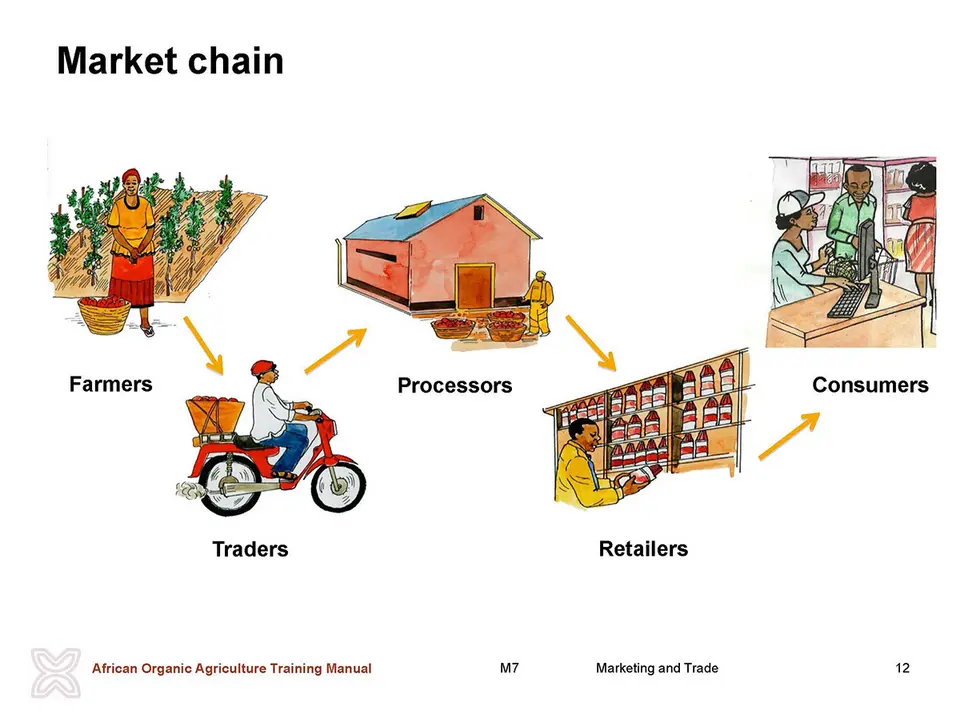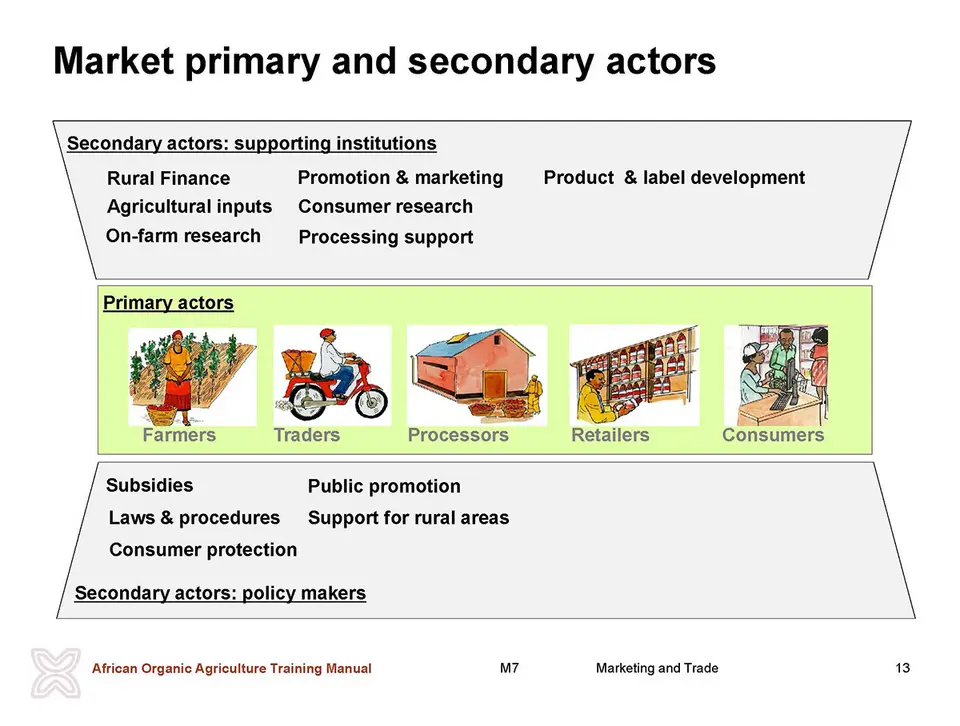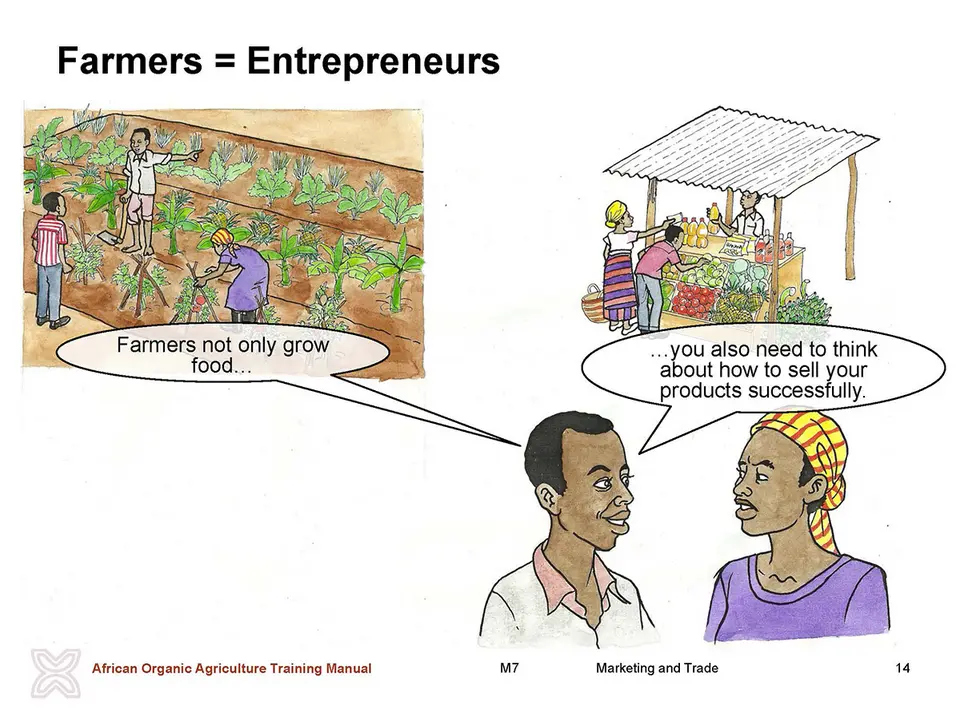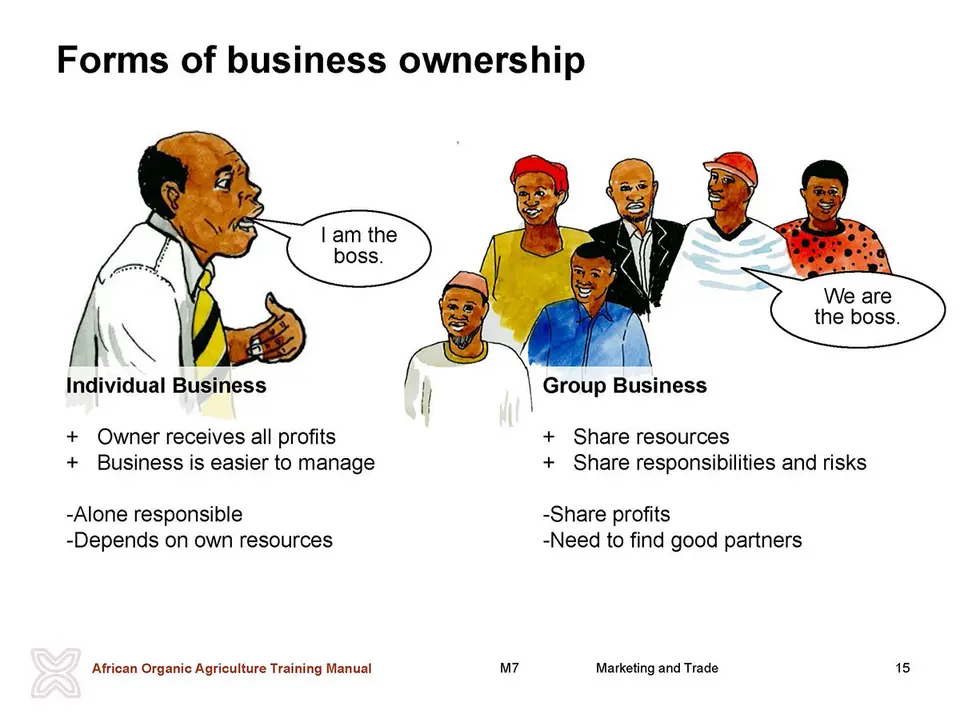Competitiveness and organization of the organic market chain
Both export and domestic markets involve considerable challenge to farmers. So, how can producers compete in such markets, which are especially demanding with regard to product quality in the case of organic product? Most important are good business contacts that link them up with final consumers. In this sense, the ’organic business’ is not the business of an individual farmer; it is, in fact, the business of a whole group of actors linked with each other as part of a market chain.
Overall, the competitiveness of the ’organic business’ relates to functional partnerships along the market chain and an on-going innovation process that enables those involved to constantly identify and take advantage of new market opportunities. To make this happen, the actors involved must effectively interact with each other by constantly sharing relevant information and building mutual trust. Only in this way will optimum use be made of available resources, which are transformed into products and services that are of value to market chain actors and consumers. If this is the case, the organic market chain has a strong ’value chain logic’.
Difference between ‘market chain’ and ‘value chain’
All actors involved in the production, processing and selling of a product are the stakeholders of the product’s market chain: farmers, processors, logistics, warehouse keepers, local traders, exporters, retailers, etc. Each actor has a role and earns a profit for the value he adds along the chain. In situations where the different actors work together to add value at the different stages along the chain then the market chain becomes a ‘value chain’. Such cooperation can only lead to success if there is common ground and each of the chain members is willing to share the risks and benefits of the product value chain. Trust also needs to be built up, which, as with any relationship, takes time. Trust begins with understanding each other.
Who is involved in organic market chain?
There are farmers willing to produce high quality organic products, and there are the consumers interested in buying them. Between these coinciding interests, there is the effort necessary to organise the business and bring the actors of the market chain together. The main question of this section is: How does one bring the needs and expectations of market partners together in order to make a successful organic business? A first step to answer this question is to understand, who is involved in organic marketing and what are specific interests of each actor of the organic market chain.
A market chain of a given product comprises all people involved in the production, processing and selling of that product (i.e. farmers, processors, transporters, warehouse or storekeepers, local traders, exporters). These are called the primary actors in the market chain because they directly handle the product. Therefore, there is a coffee market chain, a mango market chain, etc. The members of this market chain are called actors and each one has key roles and interests. Each actor also earns a margin for the value he/she adds along the chain. However, in order to succeed, each market chain actor should cooperate to establish a common ground where members are willing to share risks and benefits associated with the product. Trust also needs to be built up, which, as with any relationship, takes time.
There are other market chain actors who are not directly involved, but provide support services to facilitate the smooth functioning of the chain. These are called secondary actors and they include extension advisors, transporters, certification bodies, funders/credit institutions, etc. Secondary actors are either private or public, and have in common that they both provide tangible services to both primary and secondary actors (i.e. support and policy functions).
Market chains differ in size depending on the various factors including the product handled, target market, the use of the product. Some chains are short (e.g. where a farmer sells directly to consumers) and other market chains are longer (e.g. where a farmers sells to a broker who sells to a processor who sells to a wholesaler who sells to a retailer and finally to a consumer).
Actors of the market chain and their functions
a. Primary actors:
- Farmers - The primary role of farmers in the market chain is agricultural production. However, this role can be improved if a farmer views him/herself not only as producer, but an entrepreneur. In that case, he/she will not just think of food for the household but also crop or animal products for marketing in order to earn income.
- Processors - A food processor is a smaller craft or a larger industry that adds value to a product by processing it. Examples of processing activities include drying, threshing and milling, mixing, fermenting or producing of other products. In many cases, it is not possible to sell an agricultural product without any processing, e.g. cocoa, coffee or cotton. However, most farmers or cooperatives engage in primary processing to make the product more suitable for secondary processing which is done by bigger companies that request specific qualities in terms of product specifications.
- Traders (also called intermediaries) - Match making between farmers, processors, retailers and consumers is the main function of traders. Traders can promote farm products and provide access to customers and markets. Traders are usually well informed about prices, actual market situation, local and international legislations and standards, which regulate quality aspects such as organic and food safety and socio-economic aspects such as fair trade. Farmers who are as well informed about the market are in a better position to negotiate with the traders. Some farmers cooperate together and engage in trading themselves in order gain back a part of the value adding along the food chain. Farmers who are not at all informed about the market and its requirements will, on the other hand, completely depend on traders.
- Wholesalers - These may buy products directly from farmers, processors or through traders in bulk and then sell to retailers in smaller quantities. They may re-package or just store the products before selling to retailers.
- Retailers - Shops or markets that sell to end consumers take an important role in the distribution of agricultural products. In many cases, retailers actively promote the products with product information campaigns and promotions in the shops and in the media.
b. Secondary actors:
- Investors - Many organic agriculture projects require considerable investments in farm infrastructure, processing technologies, marketing and knowledge transfer. Mainly private, but also public investors are particularly interested in financing organic agriculture projects. Their goal is to reach a break-even point within a defined period, which includes a certain pressure towards the business orientation of a project.
- Service providers/advisors e.g. NOAMs - provide different services ranging from advisory services, market information and support, organization of farmers, farmers’ groups and coordination of organic stakeholder activities. Service providers also include suppliers of inputs, credit, transport and all other support activities in the chain.
- Certifiers - They provide the inspection and certification service in order to guarantee the organic integrity of products to consumers.
- Government - Many governments provide attractive support programmes for the organic sector, especially for export promotion. Some countries provide specific services for organic farming projects such as information desks and statistics. Most authorities in African countries have an accreditation body for organic certification, which annually evaluate and accredit local and international certification bodies. Some countries developed or are in the process of developing organic legislations. Some countries fund organic research and advisory services.
Group discussion: Understanding of a market chain
Let the participants design market chains for any given common crop or animal products grown in the area. Form groups depending on the number of chosen crops to be discussed. Let each group discuss the following questions:
- Who are the actors involved in this market chain?
- What is the role of each actor in the chain?
- How can the actors cooperate to make the chain more successful?
Group work:
Ask the participants to build groups of 3-4 participants for each available actor-group of the value chain. Let them discuss the following questions:
- What are the interests of a specific actor-group?
- What are the challenges, strengths and weaknesses of the role of this group compared to the complete market chain?
- Which factors make an organic business successful for this specific actor-group?
Improved farmer participation in the marketing chain
The farmers’ role in the market chain can be looked at from ‘within and beyond the farm’. Traditionally, farmers thought about growing enough food to feed their families to ensure household food security and sell to the market what is left over. However, the farmer can be more proactive by finding out what the market wants and then consequently produce products for food and the market. In addition, the farmer can try to improve the value of the products in order to get the best price. A way to increase the value of farm products and to earn more income at farm level is to process own products on the farm. For example, a farmer can produce his own marmalade from the fruit of his/her farm. However, getting the proper tools and equipment involves additional costs, which may require that the farmer works with other farmers together in a group or work together with a processor in order to succeed. How farmers can organise their business depending on the case is explained in section 4.3.
Organization of an organic business along the market chain
It is possible for a farmer close to a city to sell all his/her products directly to consumers from his or her farm shop. However, in many cases not any one single farm is able to supply the volume required by the principal market actors. This is especially true for the export market. It is also quite obvious that many value-added activities like product development, branding and effective promotion are difficult for the individual farmer to achieve. There are many different ways to organise a business.
a. Individual business
A farmer can do the farming business fully on his/her own as a sole proprietor. The farm is owned and run by one individual or farmer’s family. This type of ownership is very common in agriculture all over the world, especially with big farms and has the following advantages:
- The owner receives all profits.
- The farm business is easier to manage and cheaper to start and discontinue.
- It is also easier to combine with other non-agricultural activities.
However, the individual farmer is alone responsible for the success of the farming business. He needs his own financial capital to start and to provide all the money required for production purposes and is responsible for all losses and debts.
On the other hand, an individual business can cooperate with other individual businesses in the form of a partnership. This can be done between farms involved in the same activities of different activities in the value chain. This implies that they can produce and/or sell together and share production and/or marketing risks, profits and losses.
Horizontal and vertical cooperation
Two ways in which an individual farm can cooperate with other farm businesses:
- Horizontal cooperation is between farms who are at the same business level, for example, two coffee farms;
- Vertical cooperation is when at least two farms at different levels work together, for example, a coffee farm and a coffee miller, trader or retailer as an outgrower supplier.
Group work: organising an organic business
Ask the participants about the different ways of organising an organic business. Let them create an organic business and plan resources, let them discuss the following questions:
- How does one manage production activities and risks?
- How does one manage marketing and sales?
- What are some success factors of the organic business organisation?
b. Group businesses
Cooperatives are very common in agricultural production, especially in organic production involving small-holder farmers. A cooperative is a voluntary association of farmers that come together to meet their common economic and social goals. Cooperatives allow farmers to live independently within their community and at the same time share risks, resources and benefits with other farmers. A cooperative normally includes farmers who are involved in the same activities in the value chain of one or more products.
Finding the right partners and networks
As mentioned already, finding the right partners and networks can not only help generate ideas, but help become more powerful. The fact is that in most cases, only very large farmers are able to supply the volume required by well-established customers. Many value-added activities, such as processing and marketing activities are difficult for the individual producer to achieve. One way in which a producer makes these activities more effective is by working with other partners.
Finding the right partners and networks for the multiple tasks in the value chain is especially important in the case of organic products, as quality expectations and certification requirements are demanding. Horizontal and vertical partnerships can not only help generate ideas, but together you can be more powerful and have more possibilities for getting local market access and access to bigger markets regionally and internationally.
Building a network out of some of the above-mentioned stakeholders when organising an organic business is a first step towards building market power and trust. It is important to be aware of the perspective of each participating stakeholder (actor) in order to gain a common understanding the role of each stakeholder and the necessary functions in the value chain.
Checklist: questions regarding cooperation
- Main goal of the cooperation?
- Key benefits expected from the cooperation?
- What form of cooperation is the right form for our business?
- Which cooperation partners are suited to our business or business idea?
- How can each stakeholder in the chain play its role successfully?
- What are the main challenges and who can provide support to overcome them?
- Who might help promote the business, especially through the media?
- Which associations or organisations might be beneficial for our business or business idea?
- Who else in the immediate business environment can help upgrade the business?
Brainstorming: cooperation among farmers
Ask the participants to list the questions and concerns they have in mind regarding cooperation. Use a pin wall or flipchart. After the brainstorming, you organise and prioritize the results together with the participants. Draw conclusions on how to best plan and implement cooperation.




 tap and then scroll down to the Add to Home Screen command.
tap and then scroll down to the Add to Home Screen command.